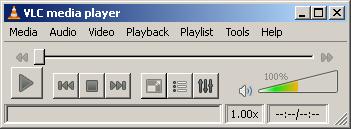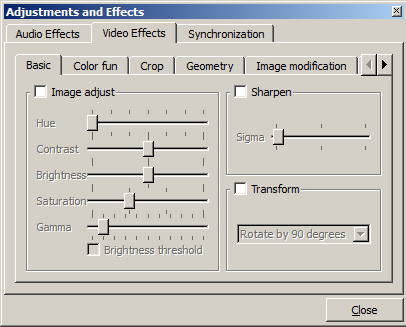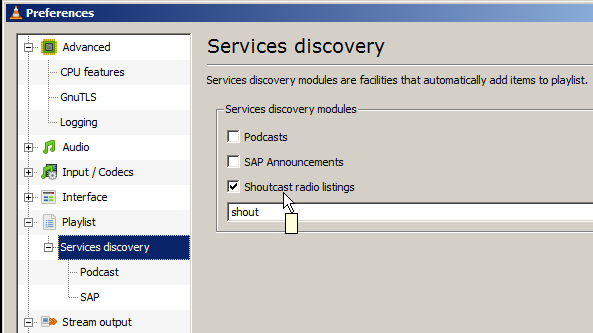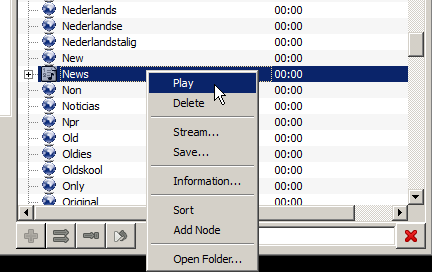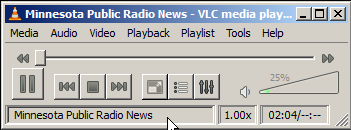Difference between revisions of "Documentation:Play HowTo/Basic Use"
| Line 60: | Line 60: | ||
<table> | <table> | ||
<tr> | <tr> | ||
| − | <td>Button</td> | + | <td><b>Button</b></td> |
| − | <td>Description</td> | + | <td><b>Description</b></td> |
</tr> | </tr> | ||
</table> | </table> | ||
Revision as of 05:35, 31 December 2008
Note: this documentation is for versions 0.9 and newer and is under construction. For simple help with 0.9 see VLC for dummies: an introduction to VLC. For older versions please see and Basic Use.
Contents
About VLC media player
VLC media player is a highly portable multimedia player for various audio and video formats such as MPEG-1, MPEG-2, MPEG-4, DivX, mp3 and ogg. It also plays DVDs, VCDs, and various streaming networks. In addition to playing audio and video files, VLC media player provides additional formats which can be played and customized.
VLC media player was initially known as VideoLAN Client. However, in recent years, the software has also become an extremely powerful server to stream live and on-demand video in several formats to the intranet network and the Internet.
It started as a student project at the French École Centrale, Paris, but is now a worldwide project with developers from more than 20 countries.
VLC is built in a modular way. This means that you can choose from a range of different modules to decide how to control VLC and how to display the video output.
Note: The screenshots are taken from the MS Windows XP version. On other operating systems they might appear slightly different.
Understanding the VLC interface
VLC has several interfaces:
- A cross-platform interface, for Windows and GNU/Linux, called wxWidgets,
- A native Mac OS X interface, and
- A skinnable interface for Windows and GNU/Linux.
Screenshots below are drawn from the various interfaces, but VLC's functions work essentially the same on all operating systems.
Windows and GNU/Linux (Qt)
The main interface of VLC media player looks as shown in the following figure. This is the default interface on Windows and GNU/Linux (the screenshot is done on Windows, but it would look quite the same on GNU/Linux).
Starting VLC Media Player
To start VLC Media Player
- Select Programs from the Start menu.
- Select VideoLAN and select the VLC media player.
When you start VLC media player, the application appears on the screen and a small icon File:VLCIcon.jpg appears in the taskbar. Click on the icon in the taskbar to show or hide the icon in the taskbar. Hiding the icon does not amount to quitting the application. It does run in the background even when you hide the interface.
Stopping VLC Media Player
To quit the application, right click on the File:VLCIcon.jpg icon in the tray and select Quit.
Or
Click the Close button in the main interface of the application.
Taskbar Icon
When VLC media player is running, its icon File:VLCIcon.jpg appears in the taskbar. Click on the icon in the taskbar to show or hide the icon in the taskbar. Hiding the icon does not amount to quitting the application. It does run in the background even when you hide the icon. Basic operations such as opening, playing or stopping a media file, or changing a track can be done from the menu obtained by right clicking the taskbar icon. The main interface contains a couple of sections:
Main Interface
Menu bar
The menu bar at the top contains all the options.
Track slider
The track slider is below the menu bar. It shows the progress of playing the media file. You can drag the track slider left to rewind or right to forward the track being played. When a video file is played, the video appears between the menu bar and track slider.
Note: When a media file is streamed, the track slider does not move because VLC cannot know the total duration.
Control Buttons
The buttons below the slider help in controlling the play.
| Button | Description |
You can also choose to display advanced buttons on this interface. To do this, go to the Tools menu and click Advanced Controls. You will see extra buttons, such as loop and take snapshot, shown below.
This interface also features Extended Settings which contains additional features, such as Video, Audio and Synchronisation. To display or hide it, click on the button displaying the equalizer icon (three vertical sliders). Alternatively, go to the Tools menu and click Extended Settings. (VLC versions older than 0.9 named these extended settings as Extended GUI and displayed them attached to the main window.) VLC 0.9 displays these extended setting in a separate window, as shown below.
The interface's general appearance can be changed. To do this go to the Tools menu and click Preferences and select Interface.
Native Mac OS X (Cocoa)
This is the default interface on Mac OS X.
 The Mac OS X interface - this screenshot needs to be verified and updated if needed for the 0.9 interface
The Mac OS X interface - this screenshot needs to be verified and updated if needed for the 0.9 interface
This interface features an Extended GUI as well. It is called "Extended Controls" and can be opened through the Window menu.
 The Mac OSX interface with with the extended controls panel- this screenshot needs to be verified and updated if needed for the 0.9 interface
The Mac OSX interface with with the extended controls panel- this screenshot needs to be verified and updated if needed for the 0.9 interface
Basic playback
Play a file
To play a file, open the Media menu, and select the Open File menu item. An Open File dialog box will appear. Select the file you want to open, and click Open. VLC will start playing the selected file.
An alternative is to drag 'and' drop your file onto the VLC main interface or playlist window from the file explorer (Finder on MacOS X).
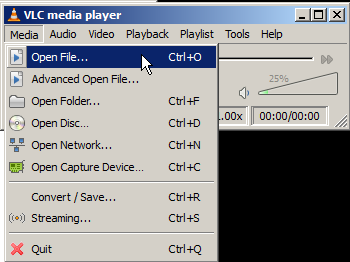
VLC 0.9.8a version Windows XP mode
 The File menu - MacOS X interface- needs verifying for 0.9
The File menu - MacOS X interface- needs verifying for 0.9
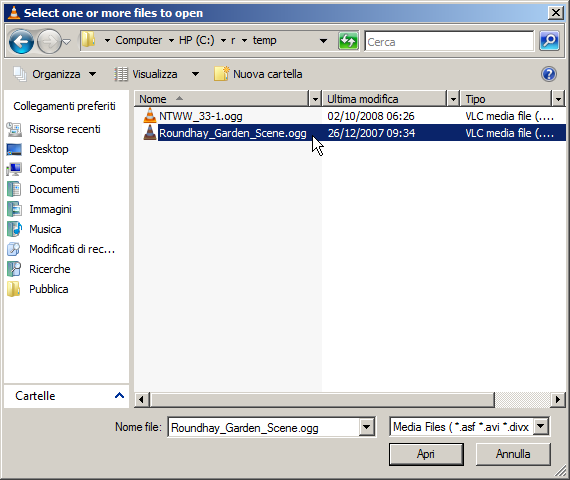 The Open file dialog - wxWidgets interface
The Open file dialog - wxWidgets interface
(need 0.9 screenshot for MacOS) The Open file dialog - MacOS X interface
Play a CD/DVD/VCD
To Play a CD, VCD or a DVD, open the File menu, and select the Open Disc... menu item. In the Open Disk Dialog Box, select the type of media (DVD, VCD or Audio CD). When reading a DVD, you can enable DVD menus by selecting the DVD (menus) disc type in the wxWidgets Interface. In the MacOS X interface, this can be done by selecting the "Use DVD menus" dialog box.
You can select the drive from which the media should be read by giving the appropriate drive letter or device name in the "Device Name" text input. This should be auto-detected on MacOS X.
If you want to start the DVD or VCD playback from a given title and chapter instead of from the beginning, you can set it using the Title and Chapter selectors.
You can start playback by selecting the Ok button.
 The Open disk dialog - wxWidgets interface- needs verifying for 0.9
The Open disk dialog - wxWidgets interface- needs verifying for 0.9
 The Open disk dialog - MacOS X interface- needs verifying for 0.9
The Open disk dialog - MacOS X interface- needs verifying for 0.9
Play a network stream (WebRadio, WebTV, etc.)
To open a network stream, open the "Media" menu and select the "Open Network" menu item.
- To open a UDP unicast stream, select UDP/RTP, and set the appropriate UDP port in the selector (it is 1234 for streams sent by a VLC or VLS server).
- To open a UDP multicast stream, select UDP/RTP multicast. Give the address of the multicast group in the "Address" text input, and select the appropriate UDP port.
- To open a stream sent over http (Webradios, WebTVs, Shoutcast, Icecast...), ftp, or mms (Microsoft Media Server), select "HTTP/FTP/MMS", and give the corresponding complete URL, (http://www.tvcultura.com.br/radiofm/radiofm.asx) in the corresponding text input. This also the way to open a RTSP stream with the MacOS X interface.
- To open a RTSP stream (sent by Darwin Streaming Server, VLC, etc), in the wxWidgets interface, select "RTSP" and give the URL in the text input.
You can start playback by selecting the Ok button.
If you get some stuttering during playback, you can try to increase the size of the read buffer. This can be done in the Open Network Stream dialog box, by selecting the Caching box. You can then choose the amount time (in milliseconds) VLC should store data in its buffer before starting playback.
 The Open network dialog - wxWidgets interface- needs verifying for 0.9
The Open network dialog - wxWidgets interface- needs verifying for 0.9
 The Open network dialog - MacOS X interface- needs verifying for 0.9
The Open network dialog - MacOS X interface- needs verifying for 0.9
Example finding a Shoutcast radio stream
This example was verified as working on 15 October 2008, using VLC 0.9.4 under Windows Vista. This needs reproducing by other people on other versions and other operating systems.
1. Ensure your firewall is set to allow the VideoLan program to make outgoing connections.
2. Click Tools then Preferences, click Interface and then click All under "Show settings". Then click the "-" next to "Playlist" in order to show the "Services discovery" submenu. If the shoutcast radio listings box is empty, click it so that a check-mark appears. The text field underneath should now show the word "shout". Click the Save button to save and close the Preferences window:
3. Restart VLC media player to make it take notice of the changed preferences.
4. On the VLC interface click Playlist, then click Show Playlist. Select the "Shoutcast Radio" in the left hand panel. If nothing appears in the righthand panel, try double-clicking "Shoutcast Radio" and waiting, it may take a few minutes the first time. After a while the righthand panel displays a long list of titles.
5. Scroll down the radio stations in the right-hand panel and select one. Click the mouse right button and click the "Play" item.
6. It may take some time for the connection to the radio station to establish (and it may fail if the station's outgoing streams are all occupied). When it does connect, VLC should start playing the audio stream from the station:
Example playing a known Shoutcast radio stream
Go to http://www.shoutcast.com/ and search for a radio station of your choice. On Windows, right-click your mouse over Shoutcast's "Tunein" button and click "Save Link As..." to save the playlist on your computer. Remember where you saved the playlist, rename it to something that makes sense.
At any time later, you can use VLC to open the saved playlist and listen to that radio station.
For example, to find a BBC World Service radio stream, use a browser to go to: http://www.shoutcast.com/directory/search_results.jsp?searchCrit=simple&s=bbc
One of the stations listed may be playing the World Service, if so move your mouse over the "TUNEIN!" webicon and click the right mouse button and click "Save Link As...", as described above.
Play from an acquisition card
This currently only possible on Linux and Windows. Open the File menu, and select "Open Capture Device..."
On Windows, supported cards include webcams, TV cards, acquisition cards... provided they come with directshow compatible drivers (Almost all acquisition cards do). You can choose the device to use for video and audio capture using the "Video device name" and "Audio device name" selectors. If your device doesn't appear in the list, try to select the "Refresh list" button. You can access the settings of your acquisition device by selecting the configure button. Options here depend on the driver of the device. You can select the "Device Proprieties" box if you want the configuration dialog box of every device to be displayed after having pressed the Ok button. Select the Tuner properties box to be prompted for tuner settings (PAL/NTSC standard, frequency...) for TV cards. The Advanced options... button allows to select some further settings useful in some rare cases, such as the chroma of the input (the way colors are encoded) and the size of the input buffer.
 The Open Capture device dialog and a device configuration windows- wxWidgets interface- needs verifying for 0.9
The Open Capture device dialog and a device configuration windows- wxWidgets interface- needs verifying for 0.9
On Linux, supported cards include webcams, TV cards, acquisition cards, provided they are supported by the Video4Linux architecture. Haupaugge PVR 250/350 cards are also supported, using the IVTV drivers.
- For Video4Linux devices, you can set the name of the video and audio devices using the "Video device name" and "Audio device name" text inputs. The "Advanced options..." button allows to select some further settings useful in some rare cases, such as the chroma of the input (the way colors are encoded) and the size of the input buffer.
 The Open Video4Linux dialog- wxWidgets interface- needs verifying for 0.9
The Open Video4Linux dialog- wxWidgets interface- needs verifying for 0.9
- To use a Hauppauge PVR card, select the PVR tab in the "Open" dialog box. Use the "Device" text input to set the device of the card you want to use. You can set the Norm of the tuner (PAL, SECAM or NTSC) by using the "Norm" Drop Down. The Frequency selector allows you to set the frequency of the tuner (in kHz), the bitrate selector to set the bitrate of the resulting encoded stream (in bit/s). The "Advanced Options button allows to set some more settings, such as the size of the encoded video (in pixels), its framerate (in frame per second), the interval between 2 key frames, etc.
After having set all the required parameters, you can start the capture by selecting the "Ok" button.
 The Open PVR dialog- wxWidgets interface- needs verifying for 0.9
The Open PVR dialog- wxWidgets interface- needs verifying for 0.9
Playlist
VLC can store a list of several files to play one after the other, using its playlist system. To access the playlist, click on the Playlist button on the main interface.
Each time you use the Open dialog box, the stream you select is appended at the end of the playlist and started.
The playlist window shows all the available streams. Double-click one to play it.
 The Playlist - wxWidgets interface- needs updating for 0.9
The Playlist - wxWidgets interface- needs updating for 0.9
 The Playlist - MacOS X interface- needs verifying for 0.9
The Playlist - MacOS X interface- needs verifying for 0.9
Adding items, saving and loading playlists
In the wxWidgets interface, the Manage menu allows you to append an item at the end of the playlist (its playback won't start immediately), to save the playlist as a M3U or PLS file, or to import a playlist file.
In the MacOS X interface, saving a playlist can be done using the Save Playlist... function in the File menu. To import a playlist file, open it the same way as any other media file, using the Quick Open File... menu item.
Sorting
In the wxWidgets interface, Sort allows you to sort the playlist according to several criteria, or to shuffle it. You can also sort by clicking the header of the column.
In the MacOS X interface, sorting can be done by clicking the header of the column matching the criteria you want to use for sorting.
Playlist modes
The playlist supports several playback modes.
In the wxWidgets interface, the toolbar contains three playlist mode buttons. They allow to enable random mode, to repeat the whole playlist or to repeat one item.
In the MacOS X interface, random mode can be enabled by selecting the Random box. A drop down menu allows you to enable playlist and item repeat modes.
Misc
Search
You also have a search tool. Enter a search string and hit search. The next item to match the string will be highlighted. Keep hitting Search to cycle between all matching items.
Moving items
In the wxWidgets interface, the Up and Down buttons at the bottom of the playlist window allow you to move an item. Select an item and use these buttons to move it.
In the MacOS X interface, you can easily move an item with the mouse, using drag-and-drop.
By right-clicking or control-clicking an item, a contextual menu will appear, giving access to a number of functions (for example, play the item, disable it, delete it, or get info on it).
If you ask for info, an item info dialog box will appear. This dialog box also allows you to change the name, the author and the location of the item to play.
 Item Info Dialog - wx Interface- needs verifying for 0.9
Item Info Dialog - wx Interface- needs verifying for 0.9
 Item Info Dialog - MacOS X interface- needs verifying for 0.9
Item Info Dialog - MacOS X interface- needs verifying for 0.9
Subtitles
VLC supports many kinds of subtitles.
Media with included subtitles
Many types of media can have embedded subtitles. VLC can read subtitles for the following media:
- DVD
- SVCD
- OGM files
- Matroska (MKV) files
Subtitles are disabled by default. To enable them, go to the Video menu, and to Subtitles track. All available subtitles tracks will be listed. Select one to get the subtitles. Depending on the media, a description (language, for example) might be available for the track.
 Select a subtitles track under Windows or Linux- needs verifying for 0.9
Select a subtitles track under Windows or Linux- needs verifying for 0.9
 Select a subtitles track under MacOS X- needs verifying for 0.9
Select a subtitles track under MacOS X- needs verifying for 0.9
DVD and SVCD subtitles are merely images, so you won't be able to change anything for them. OGM and Matroska subtitles are rendered text, so you will be able to change several options.
Text rendering options can be changed in the Preferences. In the Modules section, text renderer subsection, open the freetype page. You can then set the font and its size. For the font, you have to select a font file. Under Windows, they can be found in C:\Windows\Fonts. Under MacOS X, they are in /System/Library/Fonts. Size can be set either relatively or as a number of pixels.
You need to restart your stream for the font modifications to take effect.
Subtitles files
While modern file formats like Matroska or OGM can handle subtitles directly, older formats like AVI can't. Therefore, a number of subtitles files formats have been created. You need two files: the video file and the subtitles files that only contains the text of the subtitles and timestamps.
VLC can handle these types of subtitles files:
- MicroDVD
- SubRIP
- SubViewer
- SSA
- Sami
- Vobsub (this one is quite special: it is not made from text but from images, which means that you can't change the fonts)
To open a subtitles file, use the Advanced Open dialog box (Menu File, Open file). Select your file by clicking on the Browse button. Then, check the Subtitle options checkbox and click on the Settings button.
 Select a subtitles file under Windows or Linux- needs verifying for 0.9
Select a subtitles file under Windows or Linux- needs verifying for 0.9
You can then select the subtitles file by clicking the Browse button. You can also set a few options like character encoding, alignment and size. The delay option allows you to delay the subtitles against the video if they are not in sync. If they are not at the same speed, you might also want to adjust the subtitles framerate.
Note: For Vobsub subtitles, you need to select the .idx file, not the .sub file. Encoding, alignment and size won't have any effect for Vobsub subtitles.
Font can be changed as explained in the previous section.
Video and audio filters
VLC includes a system of filters that allow you to modify the audio and video.
Deinterlacement and Post Processing
VLC is able to deinterlace a video stream using different deinterlacement methods. Deinterlacement can be enabled in the Video menu, Deinterlacement menu item. The Blend methods gives the best results in most cases. The discardmethod is a less resource consuming alternative.
On some particular streams (MPEG 4, DIVX, XVID, Sorenson, etc.), some additional image filtering can be applied to the video before display, improving its quality in some cases. This can be enabled in the Video menu, Post processing menu item. Different levels of post processing can be chosen here. A higher level means more filtering.
Video filters
VLC features several filters able to change the video (distortion, brightness adjustment, motion blurring, etc.).
With the wxWidgets interface, filters can be easily enabled using the Extended GUI. In the Video tab, simply select the filters to enable. Image settings can be easily adjusted.
 Video filters selection in the wxWidgets interface- needs verifying for 0.9
Video filters selection in the wxWidgets interface- needs verifying for 0.9
You can enable these filters through the Extended Controls panel on Mac OS X. Click on the triangle next to Video filters to select your filters or expand the Adjust Image section to change the contrast, hue, etc.
 Video filters selection in the Mac OS X interface- needs verifying for 0.9
Video filters selection in the Mac OS X interface- needs verifying for 0.9
For better control, you need to go to the preferences. To select the filters to be enabled, go to Video, then to Filters. In the "video filter module" box, enter the names of the filters to enable, separated by semicommas. Filters will be applied in the selected order. Valid names are "clone", "wall", "transform", "adjust", "crop", "deinterlace", "distort", "motionblur" and "logo".
If you want to tune the behavior of these filters, go to Video, Filters, [your filter]. For each filter, you will find a short description and the options.
Audio filters
Equalizer
VLC features a 10-band graphical equalizer. You can display it by activating the advanced GUI on wxWidgets or by clicking the Equalizer button on the MacOS X interface.
 The equalizer in the wxWidgets interface- needs verifying for 0.9
The equalizer in the wxWidgets interface- needs verifying for 0.9
 The equalizer in the MacOS X interface- needs verifying for 0.9
The equalizer in the MacOS X interface- needs verifying for 0.9
Presets are available in the Audio menu in wxWidgets, or in the Equalizer window in the MacOS X interface.
Other audio filters
At the moment, VLC features two other audio filters: a volume normalizer and a filter providing sound spatialization with a headphone. They can be enabled in the Audio tab of the extended GUI for the wxWidgets interface and in the Audio section of the Extended Controls panel of the Mac OS X interface.
For better control, you need to go to the preferences. To select the filters to be enabled, go to Audio, then to Filters. In the "audio filters" box, enter the names of the filters to enable, separated by commas. Valid names are "equalizer", "normvol" and "headphone".
If you want to tune the behavior of these filters, go to Audio, Filters, [your filter]. The equalizer and headphone filters can be tuned.
Snapshots (aka, screenshots)
There are two ways to take snapshots (i.e., screenshots or frame grabs) with VLC:
- Go to Video -> Snapshot, or
- Press the snapshot hotkey
- Windows / Linux / Unix: Ctrl-Alt-s
- Mac OS X: Command-Alt-s
When a snapshot is taken, it will briefly preview as a thumbnail with its filename and then fade away.
To change the hotkey, go to Preferences -> Interface -> Hotkeys settings. Check Advanced options, and set Take video snapshot.
Snapshot location, format and name
The snapshot location depends upon your operating system:
- Windows: My Documents\My Pictures\
- Linux / Unix: $(HOME)/.vlc/
- Mac OS X: Desktop/
The default format for snapshots is PNG, but this may be changed to JPEG. Also, the default name for snapshots is vlcsnap- followed by a timestamp that is not the time of the frame in the video you're viewing.
The location, format and name of snapshots may be changed in the Preferences. Also, you may substitute other text for vlcsnap- in the Video snapshot file prefix and you may choose to have snapshots numbered sequentially (i.e., 000001, 000002, 000003, and so on) instead of with a timestamp. As of version 0.9.0, you may even use variables in the text used for the filename. For example, $T (must be upper case) will insert the video's time code into the file name. If you were to change the prefix to Friends-$T- while watching a DVD of Friends, then the snapshot filenames would look something like this: Friends-00_05_21-00004.png . This indicates a snapshot taken at 5 minutes and 21 seconds into the video; and it was the number 00004 snapshot of the day.
For a full list of variables, please see Documentation:Play HowTo/Format String.
Hotkeys
Most of VLC functions are accessible using hotkeys.
The list of the available hotkeys and their functions can be retrieved and altered in the preferences panel of the player. In the wxWidgets interface, preferences are available in the "Settings" menu, "Preferences" menu item. In the MacOS X interface, open the "VLC" menu, and select "Preferences". Select the "Hot keys" panel in the dialog.
As of version 0.9, a list of hotkeys is presented in a drop-down window. To change one, double-click its name to select it. Then, press the new key that will trigger the specified action. Modifier keys (such as Control/Command and Alt) may also be used.
In earlier versions, several boxes give the list of modifiers for the hotkey. To trigger an action using a hotkey, you need to press simultaneously the keys corresponding to the different selected modifiers as well as the key set in the dropdown.
To change the binding of a hotkey, select or deselect boxes corresponding to the different modifiers, and change the key by using the drop-down menu. Select the Save button to apply the changes.
 The Hotkeys Panel - wxWidgets interface- needs verifying for 0.9
The Hotkeys Panel - wxWidgets interface- needs verifying for 0.9
 The Hotkeys Panel - MacOS X interface- needs verifying for 0.9
The Hotkeys Panel - MacOS X interface- needs verifying for 0.9
Basic troubleshooting
File does not play, only sound or only video
Maybe the file you are trying to read is not fully supported. VLC does not use the codec packs (the software that decodes video signals) you might have installed. It comes with its own codecs. If there is no open-source decoder for the format you are trying to read, it won't be supported. (There is an exception, under Windows, for codecs that use the DirectShow framework.)
To find out, open the Messages Window (View menu) and restart your stream. Look for error messages (red messages)
 The wxWidgets messages window- needs verifying for 0.9
The wxWidgets messages window- needs verifying for 0.9
In this example, the file contains a IV41 video stream, a codec that is not supported by VLC.
You may of course have other messages. If you post to a VideoLAN mailing list or in the forum, please include such a log. It is very valuable in troubleshooting.
Weird VLC behavior and crashes
A very common thing is a corrupted VLC preferences file. Don't hesitate to delete it if problems appear suddenly. You will find in the FAQ details on how to delete your preferences file.
Computer crashes / Video is corrupted
Another common problem is buggy video drivers. Try upgrading them from the website of your video card's manufacturer.
Also, you can try disabling Overlay (Preferences/General/Video, untick "Overlay video output")
Please read the Documentation Editing Guidelines before you edit the documentation
